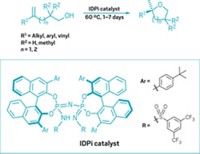Advertisement
Grab your lab coat. Let's get started
Welcome!
Welcome!
Create an account below to get 6 C&EN articles per month, receive newsletters and more - all free.
It seems this is your first time logging in online. Please enter the following information to continue.
As an ACS member you automatically get access to this site. All we need is few more details to create your reading experience.
Not you? Sign in with a different account.
Not you? Sign in with a different account.
ERROR 1
ERROR 1
ERROR 2
ERROR 2
ERROR 2
ERROR 2
ERROR 2
Password and Confirm password must match.
If you have an ACS member number, please enter it here so we can link this account to your membership. (optional)
ERROR 2
ACS values your privacy. By submitting your information, you are gaining access to C&EN and subscribing to our weekly newsletter. We use the information you provide to make your reading experience better, and we will never sell your data to third party members.
Catalysis
Oximes succumb to asymmetric hydrogenation
Iridium catalyst helps transform tough-to-reduce motif
by Bethany Halford
June 5, 2020
| A version of this story appeared in
Volume 98, Issue 22

Asymmetric hydrogenation, wherein a double bond is reduced using molecular hydrogen, is a popular way to add a stereocenter to a molecule. But asymmetric hydrogenation tends to break oximes’ N–O bonds. It is possible to use chiral oxazaborolidine borane adducts to enantioselectively reduce oximes to hydroxylamines, but that reaction can generate unwanted by-products. And cost and waste build-up make that method difficult to use on a large scale. Now, Nicolai Cramer and Josep Mas-Roselló of the Swiss Federal Institute of Technology, Lausanne (EPFL), and Tomas Smejkal of Syngenta report they can use an iridium catalyst with a chiral cyclopentadienyl ligand to asymmetrically reduce oximes under acidic conditions (Science 2020, DOI: 10.1126/science.abb2559).The reaction works on oxime ethers, as well as on free oximes, without breaking the weak N–O bond. The chemists note that the reaction can produce a desired enantiomer with a selectivity of up to 98%. To demonstrate scalability, they hydrogenated 25 g of an oxime using a scant 0.05 mol % of the catalyst (reaction shown). The reaction gave the desired methoxyamine quantitatively, indicating the catalyst facilitated about 4,000 reactions before becoming inactive. The researchers say their findings could be a blueprint for hydrogenation of challenging substrates and also highlight the potential of cyclometalated chiral cyclopentadienyl metal complexes in catalysis.





Join the conversation
Contact the reporter
Submit a Letter to the Editor for publication
Engage with us on Twitter